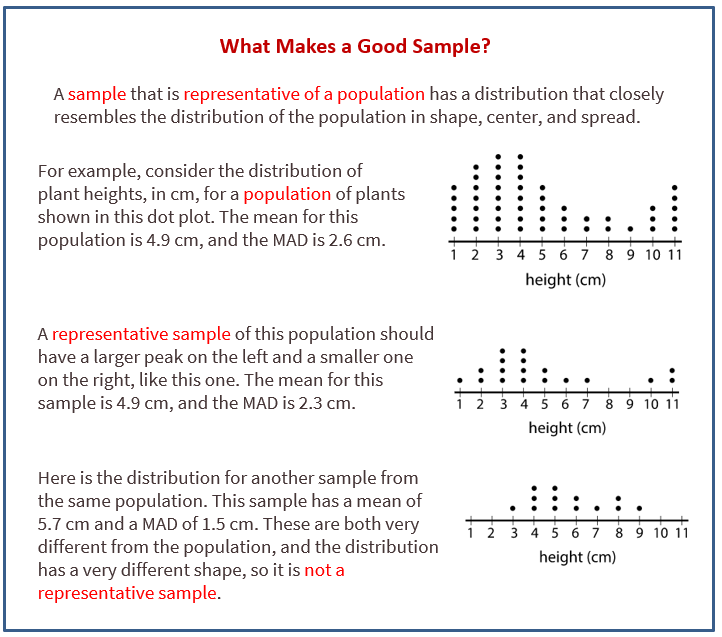Illustrative Mathematics Grade 7, Unit 8, Lesson 13: What Makes a Good Sample?
Learning Targets:
- I can determine whether a sample is representative of a population by considering the shape, center, and spread of each of them.
- I know that some samples may represent the population better than others.
- I remember that when a distribution is not symmetric, the median is a better estimate of a typical value than the mean.
Related Pages
Illustrative Math
Grade 7
Lesson 13: What Makes a Good Sample?
Let’s see what makes a good sample.
Illustrative Math Unit 7.8, Lesson 13 (printable worksheets)
Lesson 13 Summary
The following diagram determines whether a sample is a good representative of a population by considering the shape, center, and spread of each of them.

Lesson 13.1 Number Talk: Division by Powers of 10
Find the value of each quotient mentally.
34,000 ÷ 10
340 ÷ 100
34 ÷ 10
3.4 ÷ 100
Lesson 13.2 Selling Paintings
Your teacher will assign you to work with either means or medians.
- A young artist has sold 10 paintings. Calculate the measure of center you were assigned for each of these samples:
a. The first two paintings she sold were for $50 and $350.
b. At a gallery show, she sold three paintings for $250, $400, and $1,200.
c. Her oil paintings have sold for $410, $400, and $375. - Here are the selling prices for all 10 of her paintings:
Calculate the measure of center you were assigned for all of the selling prices. - Compare your answers with your partner. Were the measures of center for any of the samples close to the same measure of center for the population?
Lesson 13.3 Sampling the Fish Market
The price per pound of catfish at a fish market was recorded for 100 weeks.
- What do you notice about the data from the dot plots showing the population and each of the samples within that population? What do you wonder?
- If the goal is to have the sample represent the population, which of the samples would be good? Which would be bad? Explain your reasoning. Open Applet
Are you ready for more?
When doing a statistical study, it is important to keep the goal of the study in mind. Representative samples give us the best information about the distribution of the population as a whole, but sometimes a representative sample won’t work for the goal of a study!
For example, suppose you want to study how discrimination affects people in your town. Surveying a representative sample of people in your town would give information about how the population generally feels, but might miss some smaller groups. Describe a way you might choose a sample of people to address this question.
Lesson 13.4 Auditing Sales
An online shopping company tracks how many items they sell in different categories during each month for a year. Three different auditors each take samples from that data. Use the samples to draw dot plots of what the population data might look like for the furniture and electronics categories.
Lesson 13 Practice Problems
- Suppose 45% of all the students at Andre’s school brought in a can of food to contribute to a canned food drive. Andre picks a representative sample of 25 students from the school and determines the sample’s percentage.
He expects the percentage for this sample will be 45%. Do you agree? Explain your reasoning. - This is a dot plot of the scores on a video game for a population of 50 teenagers. The three dot plots together are the scores of teenagers in three samples from this population. Which of the three samples is most representative of the population? Explain how you know.
- This is a dot plot of the number of text messages sent one day for a sample of the students at a local high school. The sample consisted of 30 students and was selected to be representative of the population.
a. What do the five values of 0 in the dot plot represent?
b. Since this sample is representative of the population, describe what you think a dot plot for the entire population might look like. - A doctor suspects you might have a certain strain of flu and wants to test your blood for the presence of markers for this strain of virus. Why would it be good for the doctor to take a sample of your blood rather than use the population?
- How many different outcomes are in each sample space? Explain your reasoning.
(You do not need to write out the actual options, just provide the number and your reasoning.)
a. A letter of the English alphabet is followed by a digit from 0 to 9.
b. A baseball team’s cap is selected from 3 different colors, 2 different clasps, and 4 different locations for the team logo. A decision is made to include or not to include reflective piping.
c. A locker combination like 7-23-11 uses three numbers, each from 1 to 40. Numbers can be used more than once, like 7-23-7.
The Open Up Resources math curriculum is free to download from the Open Up Resources website and is also available from Illustrative Mathematics.
Try out our new and fun Fraction Concoction Game.
Add and subtract fractions to make exciting fraction concoctions following a recipe. There are four levels of difficulty: Easy, medium, hard and insane. Practice the basics of fraction addition and subtraction or challenge yourself with the insane level.

We welcome your feedback, comments and questions about this site or page. Please submit your feedback or enquiries via our Feedback page.